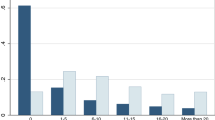Abstract
We report results of an experiment testing for present-value maximization in intertemporal income choice. Two-thirds of subjects did not maximize present value. Through a series of experimental manipulations that impose costs on non-present value maximizers, we are able to reduce the level of violations substantially. We find, however, that a sizeable proportion of subjects continue to systematically violate present-value principles. Our interpretation is that these subjects either cannot or choose not to distinguish between t income and t expenditure in making their choices. Self-management, bounded rationality, and sequence preference are suggested as possible explanations for such behavior.
Similar content being viewed by others
REFERENCES
Ainslie, G.: 1975, ‘Specious reward: A behavioral theory of impulsiveness and impulse control’, Psychological Bulletin 82, 463–509.
Ainslie, G.: 1986, ‘Beyond microeconomics: Conflict among interests in a multiple self as a determinant of value’, in The Multiple Self, J. Elster (Ed.), Cambridge: University Press.
Ahlbrecht, M. and Weber, M.: 1996, ‘An empirical study on intertemporal decision making under risk’, Lehrstuhle fur Finanzwirtschaft, forthcoming in Management Science.
Benzion, U., Rapoport, A., and Yagil, J.: 1989, ‘Discount rates inferred from decisions: An experimental study’, Management Science 35, 270–284.
Elster, J.: 1979, Ulysses and the Sirens: Studies in Rationality and Irrationality, Cambridge: University Press.
Grout, P.: 1982, ‘Welfare economics of decision making with changing preferences’, Review of Economic Studies 49, 83–90.
Keren, G. and Roelofsma, P.: 1995, ‘Immediacy and certainty in intertemporal choice’, Organizational Behavior and Human Decision Processes 63, 287–297.
Loewenstein G.: 1987, ‘Anticipation and the valuation of delayed consumption’, Economic Journal 97, 666–684.
Loewenstein, G.: 1988, ‘Frames of mind in intertemporal choices’, Management Science 34, 200–214.
Loewenstein, G. and Sicherman, N.: 1991, ‘Do workers prefer increasing wage Profiles’, Journal of Labor Economics 9, 67–84.
Loewenstein, G. and Prelec, D.: 1992, ‘Anomalies in intertemporal choice: Evidence and an interpretation’, Quarterly Journal of Economics 57, 573–598.
Loewenstein, G. and Elster, J. (eds.): 1992, Choice over Time,New York: Russell Sage Foundation.
Machina, M.: 1989, ‘Dynamic consistency and non-expected utility models of choice under uncertainty’, Journal of Economic Literature 27, 1622–1668.
Schelling, T.: 1984, ‘The intimate contest for self-command’, in Choice and Consequence, Cambridge, MA: Harvard University Press.
Shelley, M.: 1994, ‘Gain/loss asymmetry in risky intertemporal choice’, Organizational Behavior and Human Decision Processes 59, 124–159.
Strotz, R.H.: 1956, ‘Myopia and inconsistency in dynamic utility maximization’, Review of Economic Studies 23, 166–180.
Thaler, R.: 1981, ‘Some empirical evidence on dynamicinconsistency’, Economics Letters 8, 201–207.
Author information
Authors and Affiliations
Rights and permissions
About this article
Cite this article
GIGLIOTTI, G., SOPHER, B. Violations of Present-Value Maximization in Income Choice. Theory and Decision 43, 45–69 (1997). https://doi.org/10.1023/A:1004950613488
Issue Date:
DOI: https://doi.org/10.1023/A:1004950613488




